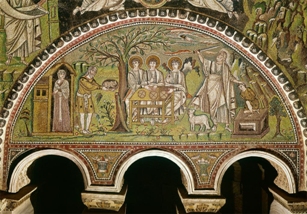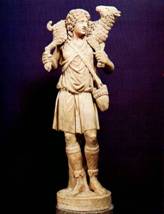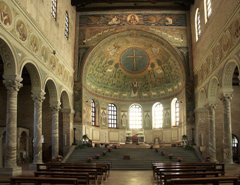RELS 1202 AA
Fall 2015
Class meets Tuesdays and Thursdays 2:00-3:15 p.m. in Fahy Hall, Room 122.
This is the September 30, 2015 version; check regularly for revisions.

The Second Vatican Council opened on October 11, 1962 and concluded on December 8, 1965. It began a process of reunifying Christianity that is still going on.
| Sept 1 |
Introduction to the course: the roots of
the Christian tradition in the Hebrew Bible
Christianity is, first of all, a tradition (or perhaps better, a stream of traditions); we all encounter it at a particular point in the history of those traditions, and any look at the Christianity of a particular time and place is a look at a point in that history. The history is a definite one, and by all accounts it begins with the collection of literature that Jesus and his contemporaries took as the word of God. In this first class we will be giving an overview of that literature and its place in the development of the Christian tradition, and a quick overview of the tradition itself. The first class will also cover the course requirements and other matters dealt with in this syllabus. See the Blackboard version of this course for the slides used in class. |
|
| Sept 3 |
God, the Covenant and
the Hebrew tradition The Exodus The covenant Read before class: The Bible: Exodus, chapters 1 through 24 |
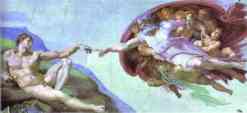 Michelangelo, The Creation of Adam Sistine Chapel |
| Sept 8 |
God, the Covenant and the Hebrew tradition
The Prophets See the Blackboard version of the course for this week's slides.
The Christian Theological Tradition, chapters 1 through 5, pp. 19-89, especially pp. 19-59 The Bible: Genesis chapters 1 through 23
|
Abraham, San Vitale, Ravenna, 6th cent. |
| Sept 10 |
God, the Covenant and the Hebrew tradition
The Exile Read before class: The Christian Theological Tradition, chapters 1 through 5, pp. 19-89, especially pp. 19-59 |
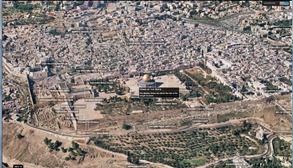 Jerusalem |
| Sept 15 |
Jesus and the Gospels
The Gospel traditions The Synoptic question See the Blackboard version of the course for this week's slides. Read before class and post a Journal entry: The Christian Theological Tradition, chapter 6, pp. 91-117 Luke, chapters 1, 2, 22, 23, 24To post a Journal entry, go to "Tools" on the Blackboard version of the course, and click on "Journals" in that menu. Choose the Journal for that week, and paste your entry there. Please do not "attach" a document there; either compose it in Blackboard, or cut/paste it from Word. Your Journal entry must be posted before the beginning of class; it will not be available to you once class begins. For each Journal entry, choose one of the questions at the end of the assigned chapter, and answer it briefly. Then add any other thoughts you may have about the materials in the chapter. What surprised you? What did you find interesting? If there is more than one chapter assigned for a particular week, choose a question from any of the assigned chapters for this assignment. Writing Assignment Choose one of the online texts (the ones which appear in blue) from this syllabus, and prepare a close reading of that text. Your reading must include a discussion of the historical context of that particular text: where and when was it written? What issues does it address? What does it take for granted? What does it say about what Christian belief means? What influence did the text have in its time and later? The final paper should be three to five pages in length. You may use the course textbook and the notes appended to the online text as part of your study; but your paper must include your own analysis of the text on the basis of that information. Some of the texts on the syllabus may be more difficult than others; please check with me in person or by email to let me know what you propose to do. An outline of your paper is due to me by October 6; and the paper itself is due no later than November 12. Note that the Resources on this syllabus can provide you with a number of valuable sources that will help you with your research project, although your final paper must reference both print and online sources. |
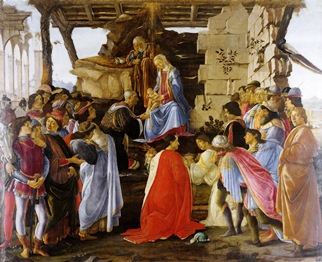 Sandro Botticelli, Adoration of the Magi Florence, Uffizi |
| Sept 17 |
Jesus and the Gospels The Gospel of John Read before class: John, chapters 1, 2, 13, 14, 18, 19, 20, 21 |
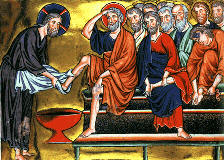 Jesus washing the disciples' feet. 13th century French |
| Sept 22 |
Christian beginnings: first preachers
Paul and the first witnesses See the Blackboard version of the course for this week's slides. Read before class and post a Journal entry: The Christian Theological Tradition, chapter 7 The Bible: The Acts of the Apostles, Paul's Letter to the Romans |
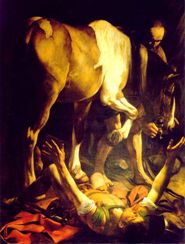 The Conversion of St Paul, Caravaggio |
| Sept 24 |
Christian beginnings: first preachers
|
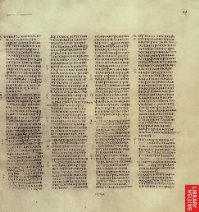 Codex Sinaiticus, a 4th century Bible |
| Sept 29 |
Early Christianity Christianity and pagan
culture See the Blackboard version of the course for this week's slides. Read before class and post a Journal entry: The Christian Theological Tradition, chapter 8
|
Jesus as the Good Shepherd Rome, 3rd century |
| Oct 1 |
Early Christianity
Persecution Read before class: The Christian Theological Tradition, chapter 8
Other reading: Letter of Ignatius of Antioch to the Romans Pagan charges of ritual cannibalism The Martyrdom of Perpetua and Felicity
|
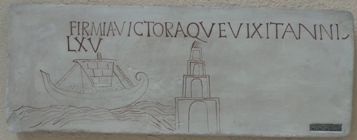 Catacomb gravestone of Firmia Victora 2nd-3rd century |
| Oct 6 |
The Imperial Church Church councils Theology as response to philosophical inquiry
See the Blackboard version of the course for this week's slides.
Read before class and post a Journal entry: The Christian Theological Tradition, chapter 9 The Creed of the Council of Nicaea
Other reading: Eusebius on the conversion of Constantine
Term paper outline due in class |
Sant' Apollinare in Classe, Ravenna |
| Oct 8 |
The Imperial Church
Other reading:
|
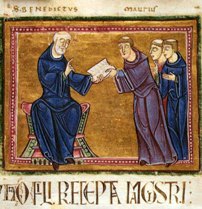 St. Benedict delivering his Rule to his monks. Saint Gilles Monastery, Nimes, 1129 |
| Oct 13 | Fall Break - No class | |
| Oct 15 | Midterm exam |
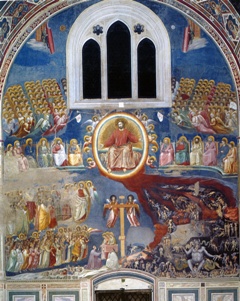 Giotto, The Last Judgment |
| Oct 20 |
Byzantine Christianity
The sacred emperor
See the Blackboard version of the course for this
week's slides. Other reading:
|
 Justinian and his court. San Vitale, Ravenna |
| Oct 22 |
Byzantine
Christianity
The patriarchate Read before class:
Other reading:
|
Iconostasis, St. George's Patriarchal Church, Istanbul |
| Oct 27 |
Latin Christianity in the Early Middle Ages
Develpment of theology See the Blackboard version of the course for this week's slides. Read before class and post a Journal entry: The Christian Theological Tradition, chapter 13 Other reading:
|
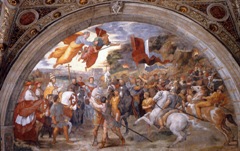 Pope Leo I and Attila. Raphael, Vatican Palace |
| Oct 29 |
Latin Christianity in the Early Middle Ages
Monasteries and bishops
Read before class: |
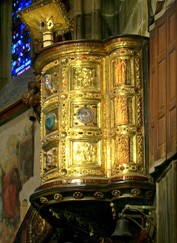 Pulpit, Aachen Cathedral Gift of Emperor Henry II in 1014 |
| Nov 3 |
Latin Christianity in the High Middle Ages
Monasteries and religious orders See the Blackboard version of the course for this week's slides. Read before
class and post a Journal entry: Other reading:
|
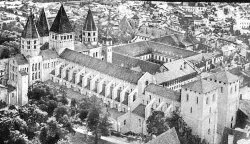 Cluny Abbey |
| Nov 5 |
Latin Christianity in the High Middle Ages
Devotion to the Virgin Mary
Read before class:
Other reading:
|
Sainte Chapelle, Paris |
| Nov 10 |
Latin Christianity in the Late Middle Ages Early reforms: Francis and others See the Blackboard version of the course for this week's slides. Read before class: The Christian Theological Tradition, chapters 16 and 17 |
 St. Francis of Assisi, by Giotto |
| Nov 12 |
Latin Christianity in the Late Middle Ages Early reforms: Francis and others
Term paper due at class |
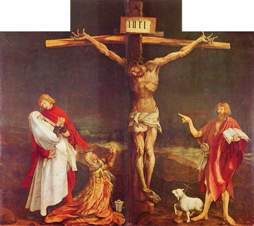 Isenheim Altarpiece, Mattias Gruenewald |
| Nov 17 |
Reformations in the Western Churches
The churches and the rising national states The
question of justification
See the Blackboard version of the course for this week's slides. Read before
class and post a Journal entry: Other reading:
|
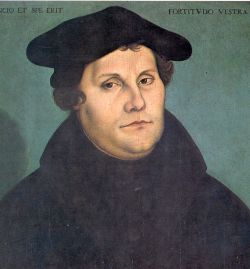 Martin Luther by Lukas Cranach |
| Nov 19 |
Reformations
in the Western Churches
The churches and the rising national states The role of the church Read before
class: Other reading:
|
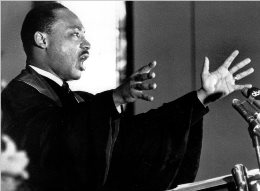 Dr. Martin Luther King preaching in Ebenezer Baptist Church |
| Nov 24 |
Roman Catholic Christianity St. Peter's Basilica
See the Blackboard version of the course for this week's slides. Read before class and post a Journal entry: The Christian Theological Tradition, chapters 20 and 21 Other reading: |
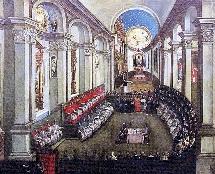 The Council of Trent |
| Nov 26 | Thanksgiving Break | |
| Dec 1 |
Roman Catholic Christianity The Jesuit order
Read before class: The Christian Theological Tradition, chapters 20 and 21
Other reading:
From the Spiritual Exercises of Ignatius of Loyola
|
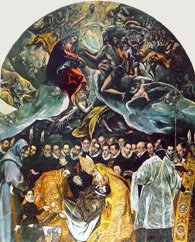 Burial of the Count of Orgaz, El Greco Toledo, Church of Santo Tomé |
| Dec 3 |
European Christianity in the modern world The French Revolution and its aftermath Development of Christian missions beyond the Americas
Religion as expression of national identity Christianity and modern thought
See the Blackboard version of the course for this week's slides. Reading
before class: |
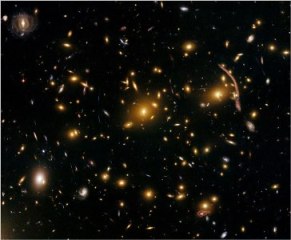 The galaxy Abell 370, photographed by the Hubble telescope in 2009 |
| Dec 8 |
American Christianity
Puritans and Cavaliers The First Vatican Council Read before
class:
|
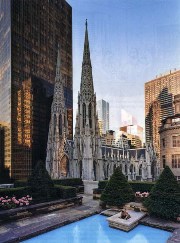 St. Patrick's Cathedral, New York City |
| Dec 10 | Review for Final Examination |
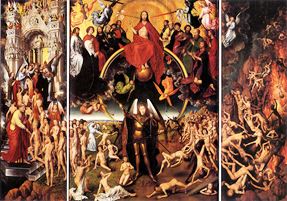 The Last Judgment, by Hans Memling |
|
Dec 22 2:30-4:30pm |
Final
Examination Date We will discuss the format of the final examination date as the time approaches. It is quite possible that the exam will be a take-home, due by the examination date, since this is the last day and last hour of the examination schedule and students may have travel arrangements that conflict with this time.
|
|
| Top of page |
Scope and Purpose of the Course
This course is intended to provide you with an understanding of the variety of ways in which Christian people have lived their faith in God. We will begin with a study of the basic stories and themes in the Hebrew Bible, which formed the religious consciousness of Jesus and the early Christians, and have served ever since as part of the authoritative sources of Christian tradition. We will then look at the evidence of the first generations of Christians: their recollection of the person and meaning of Jesus of Nazareth, and the ways in which they preserved his story in the New Testament and other early Christian writings. We will then look at the early Christian churches in the Roman empire, to see the variety of ways in which they understood and lived out their faith in Jesus: the issues which confronted them, and the ways in which they dealt with these issues.
The sudden recognition of Christianity as the official religion of the Roman empire brought to the fore the variety of understandings of the meaning of Christian belief. The Roman imperial system from Constantine forward looked to a unified Christian church as a fundamental unifying force in the crumbling empire; we will look at the ways in which the variety of Christian understandings came in conflict with the imperial need for a unitary church.
We will look particularly at two basic forms of Christianity which developed out of this imperial synthesis: the Byzantine church, Greek-speaking and centered in the imperial capital of Constantinople; and the Latin church of the western Mediterranean and north-west Europe. We will look both at the "high" theology of these churches, and at the popular forms of religious belief and practice as they developed over the centuries.
As European civilization developed in the middle years of this millennium, a variety of movements led to the development of a number of very different forms of Christianity over the course of the sixteenth century. Out of these movements developed the Protestant and Roman Catholic churches we recognize today, each with its distinctive forms of belief and practice, and each with its own sense of fidelity to the ancient Christian tradition.
In the last weeks of the course, we will examine the impact of the European contact with the non-European world on the development of the Christian tradition, with particular attention to the religious history of the United States.
Obviously, an introductory course
of this scope can not cover all that might be said or known about this
enormously rich topic; all we will be able to do is examine some representative
movements, texts, objects and other evidence of the rich diversity of Christian
belief and practice over the past two millennia. At the same time,
however, this understanding of the development of Christianity as a religious
tradition should help you understand something more of your own religious
background, and give you some of the tools to refine your sense of religion well
beyond the few weeks of this course. If you are not of a Christian
background, this course should give you a sense of who these curious
"Christians" are.
| Top of page |
The text for this course is The Christian Theological Tradition, edited by Catherine Cory and Michael Hollerich, published in third edition by Prentice-Hall, ISBN 0-13-602832-1. It is available in the University Bookstore. Each class during the semester will cover topics discussed in the textbook; you are expected to have read the assigned chapters of the textbook before the class in which the chapters are to be discussed, since the class time will be devoted to discussing the matters raised in these chapters.
The other book you will need for this course is the Bible. Any 20th-century translation of the Bible is acceptable; I personally prefer the Revised Standard Version for its fidelity to the linguistic structure of the original texts. Certain books of the Bible are included in the course reading, as noted above.
In addition, many classes will also be discussing other materials available on the Web, especially primary source text and visual materials. Links to these materials are in the syllabus; you are also expected to have studied these materials before the class in which they will be discussed. Links are visible as lines of blue text in the syllabus.
Most classes will also include a number of slides to illustrate the points under discussion. These slides will be posted before class on Blackboard, and will remain there for your continued reflection.
Grading Criteria:
- In order to make sure that you come to class prepared for discussion, you are to write a paragraph of your reaction to the reading for the class, in your Journal in the Blackboard version of this course, before the class begins. The Journal entries will count for 20% of your final grade.
- You will also be required to prepare a paper of some 3-5 pages, giving a close reading of one of the original texts assigned for the course. This paper will count for 15% of your grade.
- Your class participation will count for another 15% of your final grade.
- There will be a midterm examination, worth 20% of the final grade, given on the assigned date.
- There will also be a cumulative final examination, worth 30% of the final grade, given on the assigned examination date. The final examination will be based on the in-class review done the previous week.
Disability Services Statement: Students
at Seton Hall University who have a physical, medical, learning or psychiatric
disability, either temporary or permanent, may be eligible for reasonable
accommodations at the University as per the Americans with Disabilities Act
(ADA) and/or Section 504 of the Rehabilitation Act. In order to receive such
accommodations, students must identify themselves at the Office of Disability
Support Services (DSS), provide appropriate documentation and collaborate with
the development of an accommodation plan. The DSS phone number is 973-313-6003.
For further information, please go to
http://studentaffairs.shu.edu/health/DisabilitySupportServices.html.
| Top of page |
Resources:
In addition to the textbook and the materials referenced in the syllabus, you may find additional material of interest in the following locations:
-
The Ecole Initiative, a Hypertext Encyclopedia of Early Church History on the World Wide Web
-
The Internet Ancient History Sourcebook (website with hundreds of links to ancient documents)
-
The Internet Jewish History Sourcebook (website with hundreds of Jewish documents)
-
List of Popes from the 1913 Catholic Encyclopedia (somewhat dated, but still useful)
-
Byzantine Sources in Translation (index of available texts, with links)
-
Byzantine Studies on the Internet (website with hundreds of texts)
-
The Internet Islamic History Sourcebook (website with hundreds of Islamic documents)
-
The Internet Medieval Sourcebook (website with links to hundreds of medieval texts)
-
An excellent website (in German) on the Thirty Years' War (1618-1648)
-
The Modern History Sourcebook (website with links to hundreds of texts on modern history)
| Top of page |
Image at top of page: The Second Vatican Council was opened in St. Peter's Basilica in Rome on October 11, 1962 by Pope John XXIII. Working through four sessions, it was concluded by Pope Paul VI on December 8, 1965. The Council initiated a series of changes in the Roman Catholic Church that are still unfolding, and opened new ways for Catholics and other Christians to relate to each other, and to other religious believers as well.
